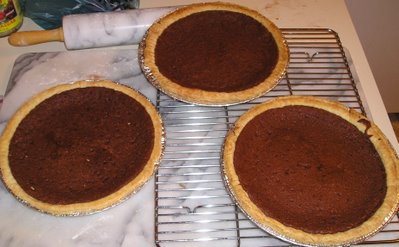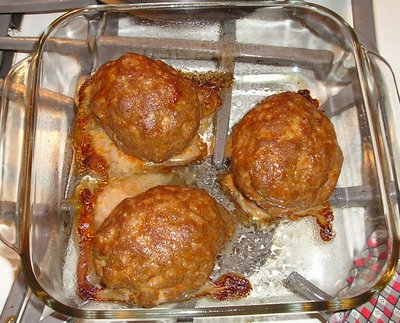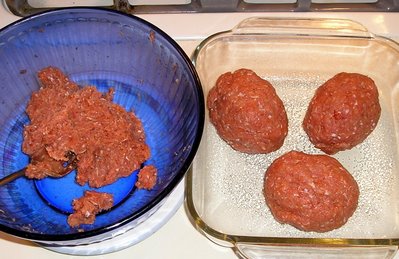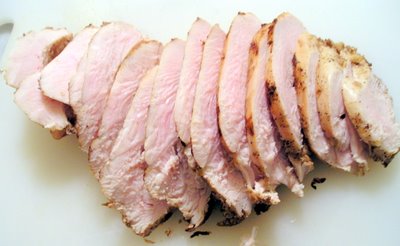The Season Begins

Before I discuss the above picture (which, for those of you who haven't guessed, is a big part of the answer to "What happened to this weekend, anyway?"), I'm going to go ahead and give you the unrelated recipe that I was going to throw at the end of this post. I made a number of changes in this year's Thanksgiving menu, and the dinner was an unqualified success. One thing I changed only slightly was my cranberry sauce.
Cranberry Sauce
1 cup sugar
1 cup water
2 cups fresh cranberries
6 kumquats, sliced very thin
1 t. grated ginger
Combine the sugar and water in a saucepan, cover, and set over medium heat. When the sugar dissolves and the water is boiling, stir in the cranberries. Simmer for five to ten minutes. Remove from heat, add the sliced kumquats and grated ginger. Let cool, then refrigerate.
The amount of time that you simmer the cranberries determines how thick your sauce is. If you want to be able to mold your sauce, then cook it until it's thick enough. You can test this by putting a saucer in the freezer and putting a few drops of the cooked cranberries on it and seeing how firmly it sets up. I normally prefer a saucier texture, but this year I went for something in between. The final product was not quite firm enough to hold its shape in a mold, but you couldn't really pour it either. It was very easy to spread on a piece of turkey.
I did use Whey Low in place of granulated sugar for this recipe. It didn't appear to affect the flavor, but while granulated sugar will usually dissolve by itself in water over a medium flame, I needed to stir the Whey Low and water a little bit to encourage it to dissolve.
You will find grating your ginger to be immensely easier if you store your ginger root in the freezer. Bear in mind that if you freeze it and use a microplane grater, one teaspoon of the grated ginger will weigh much less than a teaspoon of room temperature ginger grated by any other method, so you may want to add more.
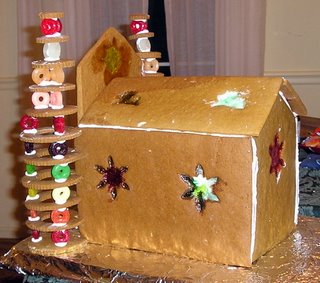
My experience leads me to believe that if you are not the sort of baker who can enjoy the process even if the end result is not perfect, then you had probably best stay away from the making of gingerbread houses. Because, let's face it, the gingerbread house I made this weekend is really not up to code. It is, nonetheless, fabulous, and I get all kinds of pleasure from seeing it on the table. Gingerbread construction is also not for the high strung: if you make a gingerbread building, things are going to go wrong, and you're going to have to be able to adapt quickly. And you must never, ever panic. Gingerbread houses have no mortgages and very high deductibles. The worst that can happen is that you end up with a lot of oddly shaped cookies.
Leaving aside the spires, which are currently free standing though I will likely affix them to the body of the temple if they do not collapse in the next week or so, there are only seven pieces to the main structure, and in the interests of not forgetting what they are and of helping anyone else who's looking for a slightly different design, I'll tell you that the two side walls are 6-inch by 9-inch rectangles. The front of the building is six inches wide. It is ten inches tall on either side and twelve inches tall in the center. After I made the front, I cut four inches off the base of the template to make the rear of the building as well as the interior arch, which you cannot see.
When you're making a gingerbread house, there are two basic ways to go. You can make large slabs of gingerbread and cut your pieces from the baked slabs. Or, you can cut your pieces from the rolled dough and then even them up (or not) once they're out of the oven. The major advantage of the first method is that you end up with pieces that are exactly the size of your templates and that are somewhat easier to work with, especially if you make the gingerbread thick enough (if, say, the dough is 1/2" thick before baking) to miter your edges. The disadvantage is that you waste a lot more cooked gingerbread. This is not so much of a problem if you use a good recipe and have hungry helpers about. For me, the main advantage of the second method is that it makes the stained glass work easier, but there's no doubt that it makes the actual erection of the gingerbread building tougher. One of my side pieces cracked while I was picking it up to put in place. I should probably have rolled my dough thicker and/or cooked it for longer. As it was, I merely accepted L.'s contention that it looked more like an old house with a crack in one of the walls.
Anyway, I'm not going to give you the recipe I used to make the gingerbread because the piece that was left over that I tasted was pretty bland. This is likely not the fault of the recipe itself. I believe that ground ginger is somewhat volatile, and I've had the same giant (16-ounce) container of it for years because the only time I use ground ginger is in holiday baking. It still smells like ginger (or it did before I threw it away this afternoon), but I put in three times as much as the recipe called for, and I could hardly taste it. I am used to tripling the amount of spices in spice cookie and gingerbread recipes, (It's my belief that many of these recipes have been handed down for many generations and originated in times when spices were prohibitively expensive and when a cookie with any ginger or cloves at all would have been a delicacy.) but when I do so, I normally get a strong and delicious flavor.
I will tell you that I rolled out my dough to something like 3/8" thick, put the template down on the dough, trimmed the dough roughly, transferred the rough-cut piece to my Silpat-covered baking sheet, and trimmed the dough carefully with a pizza cutter. After cutting, I put the baking sheet in the refrigerator for a few minutes then took it out before using cookie cutters to make the cutouts. Then I mounded crushed pieces of candy (and let me tell you, if you're in the kitchen pounding individually wrapped hard candies with a hammer, your children will fight to be the one who gets to help you) in the cutouts and baked the whole shebang at 325 for about fifteen minutes. If you follow this method, let the pieces cool most of the way to room temperature before attempting to remove them from the Silpat. The whole structure is held together with icing and straight pins.
I used fluted circular cookie cutters in a variety of diameters to make the spires. Most of the levels in the spires were cut once with a wider cutter and then a second time with a smaller cutter to produce a donut shape. I originally did this with the intent of putting a light source at the base of the spires and letting it shine out, but I'm not sure that I'll be able to pull that off. I also made a small right-angle cutout of the outside of the donut so that I could push the spires up against the building, the corners of which were meant to fit in the right-angle cutout. The right angles were difficult to cut correctly, which is a big part of why the spires lean away from the building, though I prefer to think of it as incompatible architectural elements recoiling from each other in horror.
The structure is meant to be reminiscent of a cathedral, but I decorated it principally with pagan imagery, so it's really a gingerbread sun temple. The spires, however, have a heavier Catholic influence. You can tell because the first few levels of the spires are supported by lifesavers in colors that mimic the rainbow: after all, is there anything gayer than the Catholic church?
I still have most of the construction icing left in a ziplock bag in the refrigerator, so there's a good chance that I'll be attaching more stuff to the temple at some point during the holiday season. It is easy to get carried away with decoration, but that's really part of the fun.

